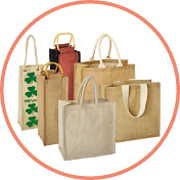
Jute diversification and value-added jute bags
Wasi Ahmed | Wednesday, 29 May 2024
 The performance of the country's jute sector in innovation and product diversification, notwithstanding progress, fails to live up to the expectations. Despite the remarkable achievement of genome sequencing of jute plants by Bangladeshi scientists in 2010, which positioned Bangladesh as a leader in the global jute industry, required follow-ups are missing. Additionally, the decline in exports of jute goods raises concerns that the country is currently not well-prepared to meet the increasing demand for diversified jute products, especially jute bags, which dominate the market.
The performance of the country's jute sector in innovation and product diversification, notwithstanding progress, fails to live up to the expectations. Despite the remarkable achievement of genome sequencing of jute plants by Bangladeshi scientists in 2010, which positioned Bangladesh as a leader in the global jute industry, required follow-ups are missing. Additionally, the decline in exports of jute goods raises concerns that the country is currently not well-prepared to meet the increasing demand for diversified jute products, especially jute bags, which dominate the market.
Demand for jute goods, especially jute sacks and shopping bags, is on a sharp rise in view of restrictions, even outright bans in many developed and developing countries on the use of bags made of artificial materials such as synthetic fibre or plastic. The reusable jute bags are biodegradable, eco-friendly and long lasting. They are a sustainable alternative to plastic and most other green or eco-type bags that are made of PP (polypropylene a petrochemical by-product) and not biodegradable.
Bangladesh, one of the top producers of raw jut with a share of 1.2 million tonnes in the annual global jute production of 2.86 million tonnes, is missing out on seizing the opportunity as the manufacturing process required for diversified and high-end jute products has not been adequately activated. A news story in a local daily, quoting the International Jute Study Group, reports that global demand for shopping bags is at present around 500 billion pieces, worth approximately $500 billion a year. This is likely to grow manifold once the US, the European countries and China - the major markets of jute bags -- begin to enforce stricter measures against use of synthetic and plastic bags.
It has been learnt that while Bangladesh manufacturers in both the public and private sector are yet to move in a proactive manner, manufacturers in neighbouring India are gaining increased market access through large-scale product diversification and adaptation as per market requirements.
Concerned quarters are of the opinion that export of raw jute to China, India, the Middle East and the African region is, to a great extent, responsible for impeding large-scale production of diversified jute goods. There is a definite supply constraint which, coupled with the lack of product development and adaptation, has limited the scope of enhancing the current base and range of jute goods, especially high-end bags. According to Export Promotion Bureau statistics, Bangladesh exported raw jute and jute goods worth $1.03 billion in fiscal 2012-13, in which jute sacks and bags accounted for $237 million. In recent times, there has been a noticeable decline in the export of sacks and bags.
Allowing export of raw jute over the last few years is considered by many sector experts a wrong decision that besides causing inadequate supply has adversely affected innovation and diversification. Lately, however, the government has put a ban on export of raw jute.
Sacks and bags currently being exported from Bangladesh are not actually meant for the prospective markets. In fact, value addition in traditionally manufactured sacks which are mostly used to carry grains is minimal compared to that of bags of myriad varieties, dyed and laminated with eye-catching designs. So, the data available on export of jute bags and sacks do not reflect Bangladesh's accessing the upper segment of the bag market.
Viability of jute for replacing artificial and non-biodegradable materials in the shopping bag segment is unquestionable because it is far cheaper compared with all other natural fibres and additionally eco-friendly. This precisely explains the shooting up of demand for jute bags. Sadly, Bangladesh bogged down by the traditional manufacturing and marketing techniques, is yet to make its presence felt in the relatively high value added markets overseas. Understandably, to come up with new production lines calls for newer technology and intensive research and development. For that to take place, the onus is definitely on the public sector that has the capacity to make the required investment.
Experts hold that although it is already late, right initiatives could still pave the way for the desired take off. The state-owned Bangladesh Jute Mills Corporation (BJMC) has indeed a pivotal role to play. Among other things, it is believed, the primary job would involve manufacturing the appropriate jute fabric suitable for a variety of uses such as shopping bags, school bags, wine bags and so on. As a starter, the BJMC can consider dedicating one or two of its mills for production of suitable jute fabric, as a departure from traditional hesian and sack making, to feed the growing demand of diversified jute products, especially bags. To accomplish the job in terms of standard compliance, the BJMC may tie up with relevant institutes/organisations for lab testing and related activities. Also there is the need for market research to know the requirements and preferences of target markets.
wasiahmed.bd@gmail.com